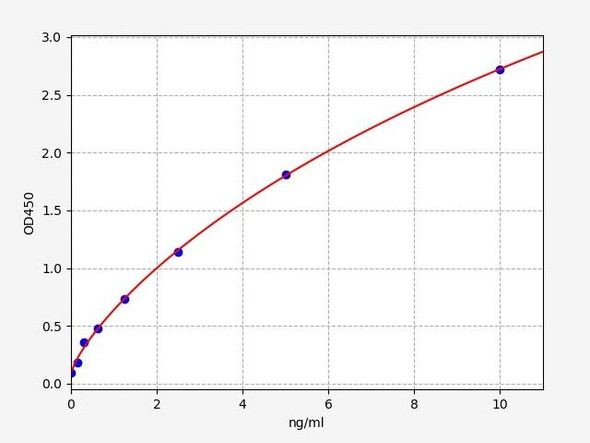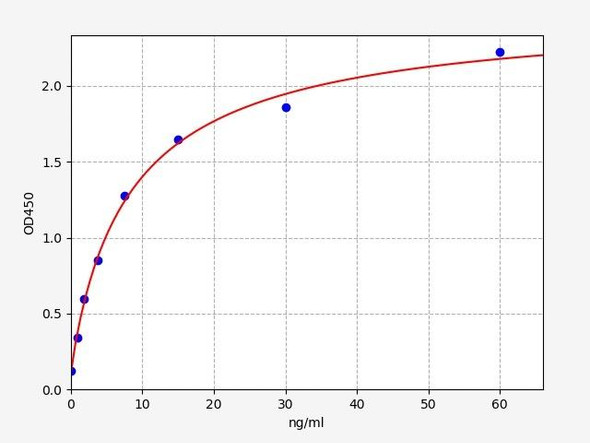Human Amyloid beta A4 protein (APP) ELISA Kit
- SKU:
- HUEB0323
- Product Type:
- ELISA Kit
- Size:
- 96 Assays
- Uniprot:
- P05067
- Range:
- 15.6-1000 pg/mL
- ELISA Type:
- Sandwich
- Synonyms:
- ABeta40, Amyloid Beta 40, Abeta 40, Beta-amyloid protein 40, ABeta, 1-40
- Reactivity:
- Human
Description
| Product Name: | Human Amyloid beta A4 protein (APP) ELISA Kit |
| Product Code: | HUEB0323 |
| Alias: | Amyloid beta A4 protein, ABPP, APPI, APP, Alzheimer disease amyloid protein, Cerebral vascular amyloid peptide, CVAP, PreA4, Protease nexin-II, PN-II, APP, A4, AD1 |
| Uniprot: | P05067 |
| Reactivity: | Human |
| Range: | 15.6-1000 pg/mL |
| Detection Method: | Sandwich |
| Size: | 96 Assay |
| Storage: | Please see kit components below for exact storage details |
| Note: | For research use only |
| UniProt Protein Function: | APP: a cell surface receptor that influences neurite growth, neuronal adhesion and axonogenesis. Cleaved by secretases to form a number of peptides, some of which bind to the acetyltransferase complex Fe65/TIP60 to promote transcriptional activation. The Abeta peptide is released from the cell, its extracellular deposition and accumulation form the main components of amyloid plaques in Alzheimer's disease. Mutations in this gene have been implicated in autosomal dominant Alzheimer disease and cerebroarterial amyloidosis. Can promote transcription activation through binding to Fe65-Tip60 and inhibits Notch signaling through interaction with Numb. Couples to apoptosis-inducing pathways such as those mediated by G(O) and JIP. Inhibits G(O) alpha ATPase activity. Acts as a kinesin I membrane receptor, mediating the axonal transport of beta-secretase and presenilin 1. Involved in copper homeostasis/oxidative stress through copper ion reduction. In vitro, copper-metallated APP induces neuronal death directly or is potentiated through Cu(2+)-mediated low-density lipoprotein oxidation. Can regulate neurite outgrowth through binding to components of the extracellular matrix such as heparin and collagen I and IV. Induces a RAGE-dependent pathway that activates p38 MAPK, resulting in internalization of amyloid-beta peptide and leading to mitochondrial dysfunction in cultured cortical neurons. Provides Cu(2+) ions for GPC1 which are required for release of nitric oxide (NO) and subsequent degradation of the heparan sulfate chains on GPC1. Binds, via its C-terminus, to the PID domain of several cytoplasmic proteins, including APBB family members, the APBA family, JIP1, SHC1 and, NUMB and DAB1. Binding to DAB1 inhibits its serine phosphorylation. Associates with microtubules in the presence of ATP and in a kinesin-dependent manner. Amyloid beta-42 binds nAChRA7 in hippocampal neurons. Beta-amyloid associates with HADH2. Soluble APP binds, via its N-terminal head, to FBLN1. Expressed in all fetal tissues examined with highest levels in brain, kidney, heart and spleen. Weak expression in liver. In adult brain, highest expression found in the frontal lobe of the cortex and in the anterior perisylvian cortex- opercular gyri. Moderate expression in the cerebellar cortex, the posterior perisylvian cortex-opercular gyri and the temporal associated cortex. Weak expression found in the striate, extra- striate and motor cortices. Expressed in cerebrospinal fluid, and plasma. 10 isoforms of the human protein are produced by alternative splicing. Isoform APP695 is the predominant form in neuronal tissue, isoform APP751 and isoform APP770 are widely expressed in non- neuronal cells. Isoform APP751 is the most abundant form in T-lymphocytes. Appican is expressed in astrocytes. The splice isoforms that contain the BPTI domain possess protease inhibitor activity. Belongs to the APP family. |
| UniProt Protein Details: | Protein type:Receptor, misc.; Membrane protein, integral; Cell surface; Transcription factor; Apoptosis Chromosomal Location of Human Ortholog: 21q21.3 Cellular Component: Golgi apparatus; extracellular space; cell surface; integral to plasma membrane; integral to membrane; coated pit; intercellular junction; cytosol; ER to Golgi transport vesicle; lipid raft; ciliary rootlet; perinuclear region of cytoplasm; nuclear envelope lumen; cytoplasm; synapse; dendritic shaft; neuromuscular junction; endosome; receptor complex; intracellular membrane-bound organelle; extracellular region; dendritic spine; axon; apical part of cell; plasma membrane; spindle midzone Molecular Function:serine-type endopeptidase inhibitor activity; heparin binding; identical protein binding; protein binding; protease activator activity; enzyme binding; DNA binding; transition metal ion binding; PTB domain binding; acetylcholine receptor binding; receptor binding Biological Process: extracellular matrix organization and biogenesis; adult locomotory behavior; mRNA polyadenylation; locomotory behavior; positive regulation of mitotic cell cycle; protein amino acid phosphorylation; regulation of translation; platelet degranulation; synaptic growth at neuromuscular junction; forebrain development; dendrite development; visual learning; collateral sprouting in the absence of injury; neuromuscular process controlling balance; cell adhesion; neurite development; cholesterol metabolic process; platelet activation; Notch signaling pathway; cellular copper ion homeostasis; regulation of epidermal growth factor receptor activity; axon cargo transport; mating behavior; regulation of multicellular organism growth; endocytosis; axon midline choice point recognition; smooth endoplasmic reticulum calcium ion homeostasis; negative regulation of neuron differentiation; neuron apoptosis; axonogenesis; suckling behavior; ionotropic glutamate receptor signaling pathway; regulation of synapse structure and activity; regulation of protein binding; innate immune response; positive regulation of transcription from RNA polymerase II promoter; response to oxidative stress; blood coagulation; neuron remodeling Disease: Alzheimer Disease |
| NCBI Summary: | This gene encodes a cell surface receptor and transmembrane precursor protein that is cleaved by secretases to form a number of peptides. Some of these peptides are secreted and can bind to the acetyltransferase complex APBB1/TIP60 to promote transcriptional activation, while others form the protein basis of the amyloid plaques found in the brains of patients with Alzheimer disease. In addition, two of the peptides are antimicrobial peptides, having been shown to have bacteriocidal and antifungal activities. Mutations in this gene have been implicated in autosomal dominant Alzheimer disease and cerebroarterial amyloidosis (cerebral amyloid angiopathy). Multiple transcript variants encoding several different isoforms have been found for this gene. [provided by RefSeq, Aug 2014] |
| UniProt Code: | P05067 |
| NCBI GenInfo Identifier: | 112927 |
| NCBI Gene ID: | 351 |
| NCBI Accession: | P05067.3 |
| UniProt Secondary Accession: | P05067,P09000, P78438, Q13764, Q13778, Q13793, Q16011 B2R5V1, B4DII8, D3DSD1, D3DSD2, D3DSD3, |
| UniProt Related Accession: | P05067 |
| Molecular Weight: | 770 |
| NCBI Full Name: | Amyloid beta A4 protein |
| NCBI Synonym Full Names: | amyloid beta (A4) precursor protein |
| NCBI Official Symbol: | APPÂ Â |
| NCBI Official Synonym Symbols: | AAA; AD1; PN2; ABPP; APPI; CVAP; ABETA; PN-II; CTFgamma  |
| NCBI Protein Information: | amyloid beta A4 protein; preA4; protease nexin-II; peptidase nexin-II; beta-amyloid peptide; beta-amyloid peptide(1-40); beta-amyloid peptide(1-42); alzheimer disease amyloid protein; cerebral vascular amyloid peptide |
| UniProt Protein Name: | Amyloid beta A4 protein |
| UniProt Synonym Protein Names: | ABPP; APPI; APP; Alzheimer disease amyloid protein; Cerebral vascular amyloid peptide; CVAP; PreA4; Protease nexin-II; PN-II |
| Protein Family: | Amyloid beta A4 protein |
| UniProt Gene Name: | APPÂ Â |
| UniProt Entry Name: | A4_HUMAN |
| Component | Quantity (96 Assays) | Storage |
| ELISA Microplate (Dismountable) | 8×12 strips | -20°C |
| Lyophilized Standard | 2 | -20°C |
| Sample Diluent | 20ml | -20°C |
| Assay Diluent A | 10mL | -20°C |
| Assay Diluent B | 10mL | -20°C |
| Detection Reagent A | 120µL | -20°C |
| Detection Reagent B | 120µL | -20°C |
| Wash Buffer | 30mL | 4°C |
| Substrate | 10mL | 4°C |
| Stop Solution | 10mL | 4°C |
| Plate Sealer | 5 | - |
Other materials and equipment required:
- Microplate reader with 450 nm wavelength filter
- Multichannel Pipette, Pipette, microcentrifuge tubes and disposable pipette tips
- Incubator
- Deionized or distilled water
- Absorbent paper
- Buffer resevoir
*Note: The below protocol is a sample protocol. Protocols are specific to each batch/lot. For the correct instructions please follow the protocol included in your kit.
Allow all reagents to reach room temperature (Please do not dissolve the reagents at 37°C directly). All the reagents should be mixed thoroughly by gently swirling before pipetting. Avoid foaming. Keep appropriate numbers of strips for 1 experiment and remove extra strips from microtiter plate. Removed strips should be resealed and stored at -20°C until the kits expiry date. Prepare all reagents, working standards and samples as directed in the previous sections. Please predict the concentration before assaying. If values for these are not within the range of the standard curve, users must determine the optimal sample dilutions for their experiments. We recommend running all samples in duplicate.
| Step | |
| 1. | Add Sample: Add 100µL of Standard, Blank, or Sample per well. The blank well is added with Sample diluent. Solutions are added to the bottom of micro ELISA plate well, avoid inside wall touching and foaming as possible. Mix it gently. Cover the plate with sealer we provided. Incubate for 120 minutes at 37°C. |
| 2. | Remove the liquid from each well, don't wash. Add 100µL of Detection Reagent A working solution to each well. Cover with the Plate sealer. Gently tap the plate to ensure thorough mixing. Incubate for 1 hour at 37°C. Note: if Detection Reagent A appears cloudy warm to room temperature until solution is uniform. |
| 3. | Aspirate each well and wash, repeating the process three times. Wash by filling each well with Wash Buffer (approximately 400µL) (a squirt bottle, multi-channel pipette,manifold dispenser or automated washer are needed). Complete removal of liquid at each step is essential. After the last wash, completely remove remaining Wash Buffer by aspirating or decanting. Invert the plate and pat it against thick clean absorbent paper. |
| 4. | Add 100µL of Detection Reagent B working solution to each well. Cover with the Plate sealer. Incubate for 60 minutes at 37°C. |
| 5. | Repeat the wash process for five times as conducted in step 3. |
| 6. | Add 90µL of Substrate Solution to each well. Cover with a new Plate sealer and incubate for 10-20 minutes at 37°C. Protect the plate from light. The reaction time can be shortened or extended according to the actual color change, but this should not exceed more than 30 minutes. When apparent gradient appears in standard wells, user should terminatethe reaction. |
| 7. | Add 50µL of Stop Solution to each well. If color change does not appear uniform, gently tap the plate to ensure thorough mixing. |
| 8. | Determine the optical density (OD value) of each well at once, using a micro-plate reader set to 450 nm. User should open the micro-plate reader in advance, preheat the instrument, and set the testing parameters. |
| 9. | After experiment, store all reagents according to the specified storage temperature respectively until their expiry. |
When carrying out an ELISA assay it is important to prepare your samples in order to achieve the best possible results. Below we have a list of procedures for the preparation of samples for different sample types.
| Sample Type | Protocol |
| Serum | If using serum separator tubes, allow samples to clot for 30 minutes at room temperature. Centrifuge for 10 minutes at 1,000x g. Collect the serum fraction and assay promptly or aliquot and store the samples at -80°C. Avoid multiple freeze-thaw cycles. If serum separator tubes are not being used, allow samples to clot overnight at 2-8°C. Centrifuge for 10 minutes at 1,000x g. Remove serum and assay promptly or aliquot and store the samples at -80°C. Avoid multiple freeze-thaw cycles. |
| Plasma | Collect plasma using EDTA or heparin as an anticoagulant. Centrifuge samples at 4°C for 15 mins at 1000 × g within 30 mins of collection. Collect the plasma fraction and assay promptly or aliquot and store the samples at -80°C. Avoid multiple freeze-thaw cycles. Note: Over haemolysed samples are not suitable for use with this kit. |
| Urine & Cerebrospinal Fluid | Collect the urine (mid-stream) in a sterile container, centrifuge for 20 mins at 2000-3000 rpm. Remove supernatant and assay immediately. If any precipitation is detected, repeat the centrifugation step. A similar protocol can be used for cerebrospinal fluid. |
| Cell culture supernatant | Collect the cell culture media by pipette, followed by centrifugation at 4°C for 20 mins at 1500 rpm. Collect the clear supernatant and assay immediately. |
| Cell lysates | Solubilize cells in lysis buffer and allow to sit on ice for 30 minutes. Centrifuge tubes at 14,000 x g for 5 minutes to remove insoluble material. Aliquot the supernatant into a new tube and discard the remaining whole cell extract. Quantify total protein concentration using a total protein assay. Assay immediately or aliquot and store at ≤ -20 °C. |
| Tissue homogenates | The preparation of tissue homogenates will vary depending upon tissue type. Rinse tissue with 1X PBS to remove excess blood & homogenize in 20ml of 1X PBS (including protease inhibitors) and store overnight at ≤ -20°C. Two freeze-thaw cycles are required to break the cell membranes. To further disrupt the cell membranes you can sonicate the samples. Centrifuge homogenates for 5 mins at 5000xg. Remove the supernatant and assay immediately or aliquot and store at -20°C or -80°C. |
| Tissue lysates | Rinse tissue with PBS, cut into 1-2 mm pieces, and homogenize with a tissue homogenizer in PBS. Add an equal volume of RIPA buffer containing protease inhibitors and lyse tissues at room temperature for 30 minutes with gentle agitation. Centrifuge to remove debris. Quantify total protein concentration using a total protein assay. Assay immediately or aliquot and store at ≤ -20 °C. |
| Breast Milk | Collect milk samples and centrifuge at 10,000 x g for 60 min at 4°C. Aliquot the supernatant and assay. For long term use, store samples at -80°C. Minimize freeze/thaw cycles. |










